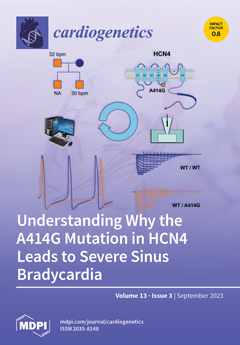Patients carrying the heterozygous A414G mutation in the
HCN4 gene, which encodes the HCN4 protein, demonstrate moderate to severe bradycardia of the heart. Tetramers of HCN4 subunits compose the ion channels in the sinus node that carry the hyperpolarization-activated ‘funny’ current (I
f
[...] Read more.
Patients carrying the heterozygous A414G mutation in the
HCN4 gene, which encodes the HCN4 protein, demonstrate moderate to severe bradycardia of the heart. Tetramers of HCN4 subunits compose the ion channels in the sinus node that carry the hyperpolarization-activated ‘funny’ current (I
f), also named the ‘pacemaker current’. I
f plays an essential modulating role in sinus node pacemaker activity. To assess the mechanism by which the A414G mutation results in sinus bradycardia, we first performed voltage clamp measurements on wild-type (WT) and heterozygous mutant HCN4 channels expressed in Chinese hamster ovary (CHO) cells. These experiments were performed at physiological temperature using the amphotericin-perforated patch-clamp technique. Next, we applied the experimentally observed mutation-induced changes in the HCN4 current of the CHO cells to I
f of the single human sinus node cell model developed by Fabbri and coworkers. The half-maximal activation voltage V
1/2 of the heterozygous mutant HCN4 current was 19.9 mV more negative than that of the WT HCN4 current (
p < 0.001). In addition, the voltage dependence of the heterozygous mutant HCN4 current (de)activation time constant showed a −11.9 mV shift (
p < 0.001) compared to the WT HCN4 current. The fully-activated current density, the slope factor of the activation curve, and the reversal potential were not significantly affected by the heterozygous A414G mutation. In the human sinus node computer model, the cycle length was substantially increased, almost entirely due to the shift in the voltage dependence of steady-state activation, and this increase was more prominent under vagal tone. The introduction of a passive atrial load into the model sinus node cell further reduced the beating rate, demonstrating that the bradycardia of the sinus node was even more pronounced by interactions between the sinus node and atria. In conclusion, the experimentally identified A414G-induced changes in I
f can explain the clinically observed sinus bradycardia in patients carrying the A414G
HCN4 gene mutation.
Full article




